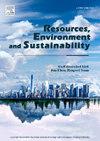被忽视的活火对全球温室气体排放的不成比例的贡献
IF 12.4
Q1 ENVIRONMENTAL SCIENCES
引用次数: 0
摘要
温室气体(GHG)排放量的急剧上升对人类社会和全球变化构成了重大的安全隐患,其主要来源是火灾以及化石和生物燃料的燃烧。自2000年以来,全球活跃火灾产生的二氧化碳排放量约为化石燃料和土地利用变化产生的二氧化碳排放量的25%。由于活火与温室气体排放的相互作用机制复杂,活火贡献的温室气体排放规模、分布和变化存在较大差异。活火对温室气体排放的贡献及其差异以及在全球尺度上的驱动机制仍然缺乏系统的了解。在此,我们结合温室气体排放、活火、土地覆盖、温度和人口产品(2003-2021),量化了火灾引起的温室气体排放的时空特征及其可能的驱动因素。自2003年以来,活火温室气体排放的比例呈波动下降趋势,但年总量几乎保持增长。在9.71 × 1.05亿吨温室气体排放总量中,活火排放约占20% (1.85 × 1.05亿吨),且区域差异显著。土地覆盖、温度和人口共同调节了全球活火对温室气体排放的不成比例贡献。大多数地区人口稀少,活跃火灾的温室气体排放量明显超过化石和生物燃料燃烧的温室气体排放量。巴西、刚果民主共和国、哈萨克斯坦、东南亚大陆和澳大利亚的活火排放占温室气体排放总量的43%以上。我们的研究结果强调了活火对全球碳排放,特别是二氧化碳排放的重要贡献。未来在减缓全球变暖、碳中和、温室气体预算和可持续发展方面的努力应考虑到火灾排放的影响。本文章由计算机程序翻译,如有差异,请以英文原文为准。

The neglected disproportionate contributions of active fires in greenhouse gas emissions globally
The steeply rising greenhouse gas (GHG) emissions poses significant safety hazards to human society and global change, which was generally sourced from fires as well as fossil and bio fuels combustion. Since 2000, global carbon dioxide (CO2) emissions from active fires have been approximately 25% of those from fossil fuels and land use change. Due to the complicated mechanisms of interactions between active fires and GHG emissions, the size, distribution, and changes of GHG emissions from active fires contributions exist wide differences. The contributions of active fires to GHG emissions and their discrepancies as well as driving mechanisms at the global scale remain poorly understood systematically. Here, we combine GHG emission, active fires, land cover, temperature, and population products (2003–2021) to quantificat the spatio-temporal features of fires-induced GHG emissions and possible drivers. Although the proportions of GHG emissions from active fires showed a descending tendency with fluctuation, the annually totality almost kept increasing since 2003. Among total 9.71 × 105 million tons GHG emissions, active fires released approximately 20% (1.85 × 105 million tons), and shows significant regional variability. Land cover, temperature, and population jointly regulated global disproportionate contributions of active fires in GHG emissions. Most areas, where GHG emissions from active fires obviously exceeded that from fossil and bio fuels combustion, were sparsely populated. Over 43% of GHG emission contributions from active fires were counted in Brazil, the Democratic Republic of Congo, Kazakhstan, Mainland of Southeast Asia, and Australia. Our findings emphasize the crucial contribution of active fires to global carbon emissions, particularly CO2 emissions. Future efforts on global warming alleviation, carbon neutrality, GHG budgets, and sustainable development should take the impact of fire emissions into account.
求助全文
通过发布文献求助,成功后即可免费获取论文全文。
去求助
来源期刊

Resources Environment and Sustainability
Environmental Science-Environmental Science (miscellaneous)
CiteScore
15.10
自引率
0.00%
发文量
41
审稿时长
33 days
 求助内容:
求助内容: 应助结果提醒方式:
应助结果提醒方式:


